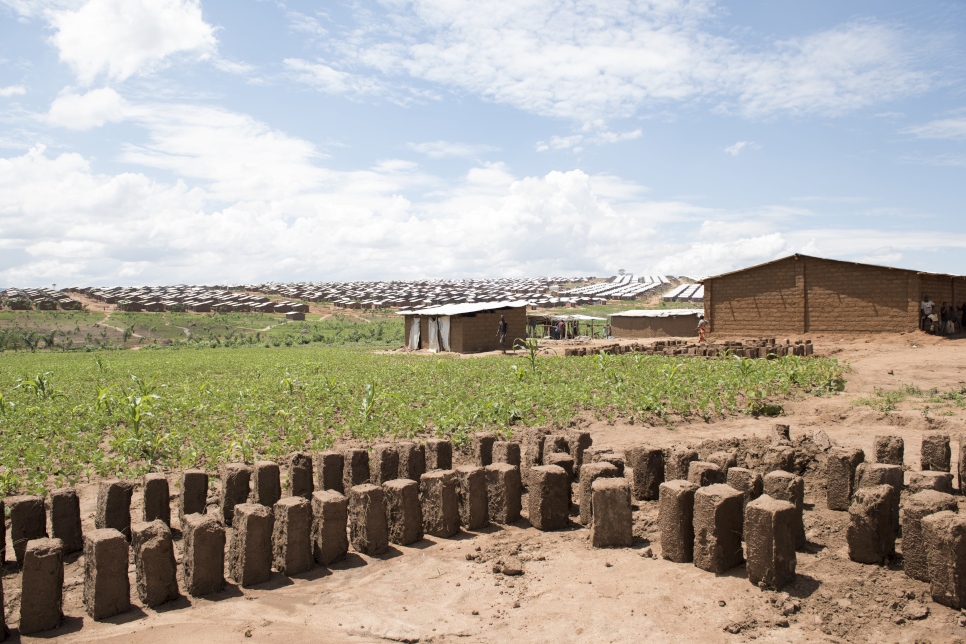How we shelter
Shelter Spotlight: Rwanda’s Dual Shelters
In 2015, when civil unrest broke out in Burundi, sparking conflict and violence, thousands of Burundians fled their homes in search of protection and safety in Rwanda. In response to the large number of Burundian refugees arriving in Rwanda, UNHCR worked with Rwanda’s government to open Mahama camp in April 2015. Today it houses over 50,000 Burundian refugees with refugees still arriving daily.
As we learn from two shelter experts working in Mahama camp, Silas Omondi and Jeff Nshimiyimana, the process of receiving Burundian refugees and finding ways to best shelter them has been no small feat.
Can you tell us about our work in Mahama Camp, sheltering Burundian refugees?
Silas: During the emergency period, the camp had more than 4,000 family tents and more than 170 temporary communal hangars. Receiving funding for shelter has made a tremendous impact on transitioning from temporary structures to the current semi-permanent shelters. Our goal is to transform 6,907 temporary structures to semi-permanent shelters.
Can you describe the dual shelters?
Jeff: The roof of a dual shelter is made from corrugated iron sheets with aluminium coatings on both sides covering the timber structure on top of walls. Each dual shelter has four rooms where eight people could comfortably live. The dual shelters are made of mud bricks produced from local soil mixed with straw as reinforcements and dried in the sun. Each shelter has 4 windows for aeration and sunlight. The doors are made from timber works with a locking system on both sides. The family living in the shelter can use a padlock to lock the door from the outside when they’re not home. The shelter can last an upwards of 10 years with adequate upkeep.
Where did the concept of the dual shelter come from?
Jeff: The concept of dual shelters was based on the need for longer term durable shelters and limitation of land for construction of the usual shelters that could accommodate all refugees in Mahama Camp. It was an innovation based on the refugee context and the hard conditions of local land availability.
How do you determine the space allocations for families to live in the dual shelter?
Silas: The Mahama dual shelter model has a different shelter topology in terms of rooms since the majority of the population are single family size. We conducted a survey to determine how to best fulfill the needs of Burundian refugee families and came up with the following formula:
- Families of one to two are allocated one room
- Families of three to six are allocated two rooms
- Families of seven to eight are allocated three rooms
- Families of nine to ten are allocated four rooms
All the rooms are partitioned and have doors fixed per each room.
What is the shelter plan for Mahama camp moving forward?
Silas: We have plans under way to demolish all the temporary shelters since we have received funds to construct semi-permanent shelters. This is currently under progress. But Mahama camp is still receiving new refugees. Even after the construction of the new shelters, there will be a gap of 593 shelters which still requires funding. There is also need to improve the three reception centres (Gatore, Bugesera and Nyanza) which are still temporary structures. Our hope is that supporters like those donating to the Global Shelter Campaign can help us fund these remaining shelters.
 Silas Omondi is a UNHCR Associate Physical Site Planner leading the shelter strategy for Rwanda’s six refugee camps. Having worked for UNHCR for the past five years in different refugee contexts for example, in Dadaab refugee camps which is one of the biggest operations hosting more than 250,000 refugees in five camps. “Our role in The Shelter and Settlement section is to support refugee operations in development of site plans, and to ensure UNHCR standards are followed from the onset of emergencies.”
Silas Omondi is a UNHCR Associate Physical Site Planner leading the shelter strategy for Rwanda’s six refugee camps. Having worked for UNHCR for the past five years in different refugee contexts for example, in Dadaab refugee camps which is one of the biggest operations hosting more than 250,000 refugees in five camps. “Our role in The Shelter and Settlement section is to support refugee operations in development of site plans, and to ensure UNHCR standards are followed from the onset of emergencies.”
 Jeff Vedaste Nshimiyaimana is a UNHCR Senior Shelter Assistant at Mahama camp. Jeff’s responsibility is to oversee the construction and development of semi-permanent shelters. Having experienced forced displacement as a young child, Jeff’s understanding of the journeys refugees have taken to find safety and the struggle of being far away from home motivates him to support them with shelter solutions. “I feel happy to be able to help refugees by providing them with basic needs.”
Jeff Vedaste Nshimiyaimana is a UNHCR Senior Shelter Assistant at Mahama camp. Jeff’s responsibility is to oversee the construction and development of semi-permanent shelters. Having experienced forced displacement as a young child, Jeff’s understanding of the journeys refugees have taken to find safety and the struggle of being far away from home motivates him to support them with shelter solutions. “I feel happy to be able to help refugees by providing them with basic needs.”

